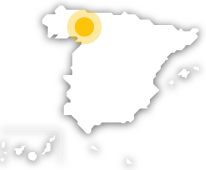
Laciana Valley Nature Reserve

Amid mountain meadows and summits
To the north of Leon, between the Mountains of Leon and the Cantabrian Mountains, the Laciana Valley unfolds, declared a Biosphere Reserve by UNESCO in the year 2002.
The Laciana Valley, the capital of which is the town of Villablino, is made of luxuriant mixed forests and is surrounded by a cirque, with summits higher than 2,000 metres. Cornón (2,188 m), Catoute (2,111 m) and Tambarón are some of the highest peaks in the region. Birch, oak, and chestnut trees form a landscape crossed by the Sil River, which sometimes runs between steep banks, creating gaps and defiles. Thickets alternate with brañas, high mountain meadows where shepherds take their flocks to graze during the summer. This protected space, also a Special Bird Protection Area (ZEPA), shelters emblematic species such as the capercaillie, endangered species like the brown bear and numerous specimens of roe deer and wild boar. The wolf, another typical animal of Spain, also frequents this valley. Cueto Nidio, which reaches a height of more than 1,700 metres, affords excellent panoramic views of the Laciana Valley. The entire area of Laciana is dotted with small traditional villages, many of which are the starting point for the various trails in the Reserve.
Laciana Valley Nature Reserve
León (Castilla y Leon)
León (Castilla y Leon):
- Villablino
Activa JS
What you need to know
-
Cultural information
In Villablino, we can visit the hill-fort of La Zamora and many others dotted around the municipality. In Robles de Laciana, we can visit a Romanesque church that was consecrated in the 11th century. The church of San Miguel, in Villablino, is another important example of rural Romanesque architecture. Among the palaces and emblazoned houses found here, the palace of Álvarez Carballo in Orallo, the house of Arias in Rioscuro and the house of Sierra and Pambley in Villablino must be noted. Rioscuro also has a Roman bridge. Raised granaries (hórreos), cattle crates and mountain meadows complete this highland scenery. Finally, in addition to many other activities, visitors can enjoy the Leitariegos Ski Resort.
-
Environmental information
In the mountain meadow of Ronda and Mount Barroso, the development of mixed forests of non-coniferous trees that are very important in the Cantabrian Mountains can be seen. To learn more about the wetlands environment, visit Vega del Palo. This area, which used to be a glacial lake, floods during the winter. As for the high-mountain ecosystems found in the reserve, they abound with heather, creeping juniper and bilberry. Also remarkable is the presence of chamois in this area.


